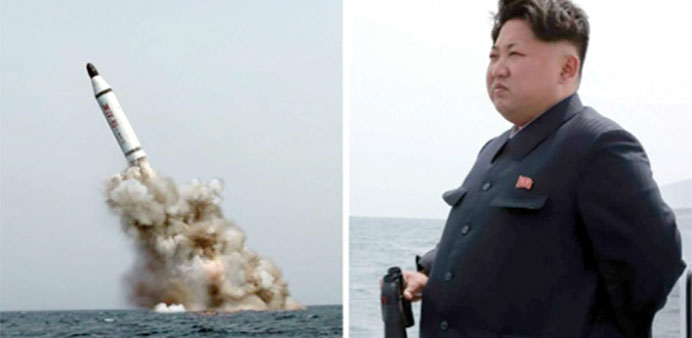Reuters/Seoul
Korea made a key step in its nuclear weapons programme by test-launching a ballistic missile from a submarine, but remains years away from developing a missile system or submarine which could threaten its sworn enemy the United States, experts said.
South Korea yesterday called the test “very serious and concerning” and urged Pyongyang to immediately stop developing submarine-launched ballistic missiles (SLBMs), which it said hindered regional security.
Isolated North Korea, already slapped with UN sanctions for its missile and nuclear tests, is widely believed to be trying to develop a nuclear device small enough to be mounted on a ballistic missile, but it is not clear whether it has done so - a crucial step to make its missile threat credible.
And while some North Korean submarines are technically capable of coming within range of the US mainland, they cannot necessarily carry a missile, although the North’s missile-equipped submarines could reach Japanese waters.
“They need to build a new, bigger submarine,” said Yang Uk, a senior research fellow at the Korea Defence and Security Forum and a policy adviser to the South Korean navy.
Both the United States and Japan reserve rights to conduct pre-emptive strikes on North Korean missile sites if a nuclear attack is viewed as imminent. Launching missiles from submarines could enable Pyongyang to hide them.
“While North Korea’s submarines are not especially effective, finding even a small number of specific submarines armed with missiles would be quite a challenge,” said Jeffrey Lewis of the California-based Monterey Institute of International Studies.
Like much of North Korea’s arsenal, its fleet of around 70 submarines is based mainly on ageing, Soviet-era technology.
North Korea had been expected to be working on an SLBM, but the speed with which it conducted an evidently successful test launch caught many by surprise.
A South Korean defence ministry official who declined to be identified said photographs released on Saturday by the North showing a missile launched from the sea appeared to be authentic.
The official also said that the North could be capable of building a fully-operational submarine equipped with ballistic missiles within two or three years - a shorter time frame than many analysts say is needed.
Before it can head towards its target on an arched trajectory, an SLBM must be ejected and travel to the sea’s surface, which is what North Korea appears to have done. The missile travelled only about 150m, the South Korean official said.
Yang said the system was likely years away from deployment because North Korean submarines were not well enough equipped to manage the radar and tracking systems required to guide a missile to its target.
Lewis said the missile that North Korea tested probably has a range of roughly 2,400km, which would require a submarine to be at sea for 60-90 days.
“That means a journey to bring the US in range would be pretty daring.”
Kim Jong-Un described it as an “eye-opening success” that provided his military with a “world-level strategic weapon”.
“We urge the North to immediately stop development of the SLBM that threatens the security of the Korean peninsula and northeast Asia,” South Korean defence ministry spokesman Kim Min-Seok told reporters.

North Korea’s leader watches the launch.
